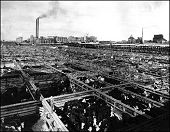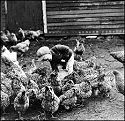Meatpacking also grew with the expansion of the railroad network and the growth of the urban market for processed foods. But meatpacking differed from milling – the product was more perishable. The development of refrigerated railroad cars permitted transporting dressed meat, rather than sending it east on the hoof.
The importance of the Twin Cities as a rail center enabled it to become a regional livestock center. Four of the “big five” meatpackers (Swift, Armour, Cudahy and Wilson) built packing plants in South St. Paul. In 1891, George A. Hormel founded a plant in Austin, and by 1920 was Minnesota’s leading meat-packer. Meatpacking had a more rapid growth in the first two decades of this century than any other major Minnesota industry.
While dairy farmers moved toward cooperative creameries, beef and hog farmers generally sold their surplus livestock to butcher shops in nearby towns.
The cattle farmer’s main market remained the local buyer, who dealt with them on a one-to-one basis. The seller had very little bargaining power and, as had the dairy farmers in the 1880s, many livestock raisers turned to the cooperative concept.
Technology, new approaches to breeding, marketing and processing, and changing lifestyles all influenced livestock raising and its related manufacturing. No segment of farm economy experienced a more revolutionary change than did poultry raising. Turkeys and chickens gradually disappeared from most farmyards, and the industry evolved into specialized poultry farms and processing companies.
Advancing technology and the further concentrations of power and control again forced labor to organize and make their voices heard in this fiercely competitive, demanding and often dangerous field of employment. [MIACOC] |
|
|
Meatpackers

Union Stock Yards, section of Cattle Division
South St. Paul, ca. 1925
Minnesota Historical Society

Boy feeding chickens, ca. 1910
Photo by H. D. Ayer
Minnesota Historical Society
Chicken-raising has moved from an informal practice to a streamlined, scientifically-based production system.
The chopping block, fire singeing and scalding tank of the early 1900s have been replaced by production-line processing that is automated, closely supervised, and highly efficient. |
|





